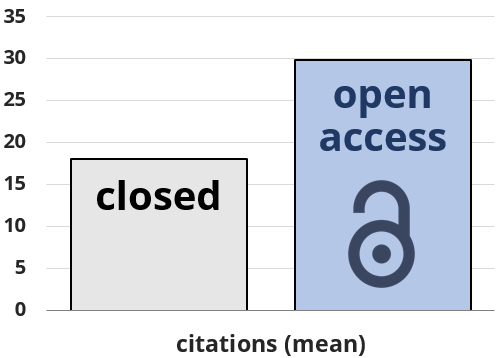My research which has had the most impact, and has led to law reform, is that which is open access.Associate Professor Alysia Blackham, Melbourne Law School, The University of Melbourne*
Open access is the term applied to research outputs that have been made freely available online. This includes journal articles, conference papers, books, and book chapters. Truly open access outputs will also have clear licences – such as Creative Commons licences – that allow further sharing and reuse.
Closed publications, by contrast, are paywalled, meaning they can only be accessed by paying a fee or using a subscription. Many higher education institutions have subscriptions to large journal or ebook databases. However, high and ever-increasing fees make such subscriptions inaccessible to many institutions. Meanwhile, one-off access costs for journal articles or book chapters are typically 40-65 AUD, making research too expensive for many people.
Benefits of open access
Making your research publications open has many benefits, including:
-
Reaching a wider audience and getting more exposure
 Altmetric data for 2015-2021 University of Melbourne journal articles shows that 77.2% of open access papers received attention. By contrast, only 57.9% of closed articles received attention.* Attention, here, includes mentions in the news, social media, policy documents, and on websites.
Altmetric data for 2015-2021 University of Melbourne journal articles shows that 77.2% of open access papers received attention. By contrast, only 57.9% of closed articles received attention.* Attention, here, includes mentions in the news, social media, policy documents, and on websites.* Altmetric data extracted from Dimensions on 21/2/2023 for 2015-2021 UoM-affiliated articles, where “open access” includes publisher and repository pathways (gold, hybrid, green).
-
Increased opportunities for citation
 Citation data for 2015-2021 University of Melbourne journal articles shows that, on average, open access articles receive 29.9 citations, while closed articles receive only 18.1 citations.* The citation advantage for open access has been confirmed in several studies, including Piwowar et al. (2018).
Citation data for 2015-2021 University of Melbourne journal articles shows that, on average, open access articles receive 29.9 citations, while closed articles receive only 18.1 citations.* The citation advantage for open access has been confirmed in several studies, including Piwowar et al. (2018).* Citation data extracted from Dimensions on 21/2/2023 for 2015-2021 UoM-affiliated articles, where “open access” includes publisher and repository pathways (gold, hybrid, green).
-
Greater potential to impact public policy and practice
“Publishing research findings behind paywalls creates barriers to the implementation of evidence-based change if practitioners, organisations, policy makers and the public cannot access this scholarly work.” (Gair et al., 2021)
-
Being inclusive of researchers around the world
“For low- and middle-income countries (LMIC), OA publishing breaks traditional financial barriers and allows unrestricted, equal access to scholarly information to people all over the globe. Due to the high prices of journal subscriptions, developing countries struggle with access just as in developed countries, but to a greater extent and consequently with greater negative repercussions.” (Tennant et al., 2016)
-
Compliance with grant requirements
ATTENTION: The NHMRC has released a new Open Access Policy. It comes into immediate effect only for NHMRC grants awarded under Grant Opportunity Guidelines issued on or after 20 September 2022. For existing grants, implementation date is from 1 January 2024. Find out more on our Funder Open Access Policies page.
The Australian Government’s two major grant funders, the Australian Research Council (ARC) and National Health and Medical Research Council (NHMRC), have open access policies.
The 2022 NHMRC open access policy requires grant-related outputs to be immediately open access upon publication. The previous NHMRC policy - which still applies in 2023 to some grant holders - requires outputs are made open access within 12 months of publication. Note that the NHMRC policies apply to peer-reviewed journal articles and peer-reviewed conferenece papers only.
The 2021 ARC open access policy requires research outputs to be open access within 12 months of publication. This policy applies to all research outputs, except preprints and data, although it encourages the open sharing of data and other outputs.
For more about the open access policies of grant providers, including the ARC and NHMRC, visit our Funder Open Access Policies page.
Principles for open access at Melbourne
The University has a position statement relating to open access: Principles for Open Access to Research Outputs at Melbourne. These Principles articulate the University’s commitment to disseminating its research as widely as possible to improve the public good. They also place an expectation on researchers to pursue repository open access for paywalled publications.
Principles for Open Access to Research Outputs at Melbourne
Pathways to open access
Today’s scholarly publishing landscape is very complex, but we can broadly identify two key pathways to open access:
- Publisher open access, in which work is published as open access, usually under a Creative Commons licence. This pathway may involve the payment of fees.
- Repository open access, in which an approved version of a publication is made open access in a repository. This will usually be the Author Accepted Manuscript (AAM), and an embargo may apply.

Publisher open access
What we’re calling publisher open access, here, covers both research outputs with fully open access publishers (sometimes called gold open access) and open access publishing by traditional or subscription publishers (also called hybrid open access).
Fully open access publishers
When publishing with an open access journal or open access book publisher, authors may have to pay an Article Processing Charge (APC) or Book Processing Charge (BPC).
However, there are many open access journals that do not levy APCs, being free for authors and readers alike. These are sometimes referred to as diamond or platinum open access journals. They are usually financially supported by institutions, organisations, or societies. Of the 18,000 journals in the Directory of Open Access Journals, over 12,500 do not charge for publishing.
There are also several BPC-free open access book publishers, including Open Book Publishers and Open Humanities Press.
Hybrid publishers
When publishing with a hybrid journal or hybrid book publisher, works that would usually be paywalled can instead be published open access for a fee (an APC or BPC). APCs for subscription journals are, on average, higher than those for open access journals. Averaging around 4,500 AUD, we have seen hybrid APCs exceed 15,000 AUD.
The hybrid publishing model is often criticised for “double dipping.” This is because publishers receive both subscription fees from libraries and APCs from authors. For this reason, the University of Melbourne discourages the payment of APCs to subscription journals, preferring the free repository open access pathway.
Many research grant funders, including the NHMRC, also discourage the payment of APCs to hybrid publishers that are not transitioning to become open access journals. See, for example, the Plan S Principles, which are prompting some subscription journals to “flip” to open access.
Open access publishing agreements
Whether going through a open access or hybrid publisher, open access fees can sometimes be avoided if an open access publishing agreement exists between the institution and the publisher. Then, if eligibility criteria are met, authors can publish open access without having to pay an APC or BPC.
The University of Melbourne has a number of agreements in place with journal publishers that can allow authors to avoid facing APCs. Find out more on our Open Access Publishing page.
Repository open access
If your work is published behind a paywall, the output can often be made open access in a repository. This usually involves making the peer-reviewed Author Accepted Manuscript (AAM) openly accessible in an institutional or subject repository. In most cases, an embargo of between 6 and 36 months will apply. This open access pathway is always free.
Publisher policies and repository open access
It often doesn’t cost us anything to achieve open access. Open access is therefore making the most of our rights as authors. Associate Professor Alysia Blackham, Melbourne Law School, The University of Melbourne*
Almost all academic journal publishers allow the AAM of an article to be made open access in a repository. Many academic book publishers will allow the AAM of a single chapter, or the author’s own chapter in an edited volume, to be made open access in such a way.
Publishers’ sharing policies can usually be found on their websites. These are sometimes called open access, green open access, or author self-archiving policies. If a publisher’s author agreement has been signed, this should also specify the author’s sharing rights.
For journals, often the easiest way to check open access policies is using the Sherpa Romeo database.
Minerva Access
University of Melbourne researchers are expected to deposit AAMs of their paywalled research in Minerva Access.
Minerva Access is University’s institutional repository for research publications. It contains over 100,000 records and saw over 2 million downloads last year.
Depositing in Minerva Access makes research discoverable through Google and Google Scholar. This means that full-text PDFs become accessible to readers without access to paywalled content.
View step-by-step instructions for depositing your research outputs on the Minerva Access website.
When University researchers deposit their work in Minerva Access, repository staff will check publisher policies and copyright before making any files public. They will apply and manage any required embargo periods and licences and get in touch with the depositing author if there are any problems.
Subject and multi-disciplinary repositories
There are a lot of open access repositories out there that can be used to share the AAMs of journal articles, conference papers, and book chapters.
Prominent general, or multi-disciplinary repositories, include:
There are a number of discipline-specific repositories, or subject repositories, that are often used for sharing AAMs. Some examples include:
- PubMed (medicine)
- Humanities Commons (humanities)
- ERIC (education)
- RePEc EconPapers (economics)
AAMs can also be shared on most preprint servers, such has arXiv.org (STEM), bioRxiv (biology), and medRxiv (medicine and health sciences). However, such platforms often do not clearly distinguish between preprints and peer-reviewed AAMs.
The Directory of Open Access Repositories (OpenDOAR) can be used to discover reputable subject repositories in your area.
Academic networking sites
Academic or scholarly networking sites, like ResearchGate and Academia.edu, can rarely be used to share AAMs. This is because most publishers require repositories to be non-commercial, while these social networking sites are commercial in nature. They tend not to be considered repositories at all.
It is always best to check your publisher’s sharing policies. Journal policies in Sherpa Romeo will usually note if sharing is permitted on academic networking sites.
For more information, see our Open Research Guide page “How to make your research open on academic networking sites.”
Further support
To discuss how you can pursue open access in your research, please email your discipline's Liaison Librarians, or arrange a time to consult a librarian.
Alternatively, you can contact the library, for any questions, feedback and suggestions please complete our Library Enquiries form below:
* Learn about Associate Professor Alysia Blackham’s experience in negotiating with publishers to disseminate more research open access through our institutional repository, Minerva Access.
Page last updated 2 March 2023.
Unless otherwise indicated, and with the exception of the open access icon, all icons used on this page were created by Freepik and are used under the Flaticon Licence.